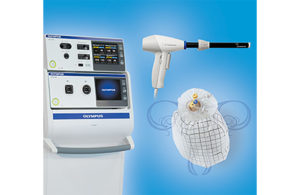
In February 2020, the FDA cleared updated labeling requirements for the Olympus PneumoLiner containment system for use with power morcellators. (Image from Olympus)
The FDA today recommended that manufacturers of laparoscopic power morcellators, which have been implicated in the spread of cancer, add noticeable and easy-to-read boxed warnings about the risks in using the devices in gynecologic procedures.
In its final guidance on the topic, the agency recommends that laparoscopic power morcellation (LPM) be limited to use with certain tissue containment systems and only in premenopausal women who have suspected fibroid tumors and are under 50 years of age. The guidance released today follows preliminary guidance issued in February.
Bench testing and simulated-use testing of containment systems have shown that they contain such tissue during morcellation, according to the FDA. But they cannot prevent cancer from spreading from tissue that was manipulated before containment or cancer that may have already spread through the blood, lymphatic system or fallopian tubes before the surgical procedure.
Power morcellators were used for 20 years to laparoscopically remove benign tumors of the uterus, known as fibroids, by mincing them. In some cases, the procedure ended up seeding undetected malignant cells throughout the abdomen, drastically accelerating the cancer’s advance. The agency began requiring a black box warning on the devices in 2014.
The final guidance recommends that manufacturers add labeling specifying the risk as it relates to age, information regarding the risk of spreading malignant and benign uterine tissue, and about the use of LPM containment systems.
It updates a 2014 document in which the agency said that the risk of an occult uterine sarcoma in a woman undergoing surgical intervention for presumed fibroids is substantially higher than had previously been assumed or reported, and higher still in women over 50. The FDA also found that the use of LPMs increased the risk of spreading benign uterine tissue, which has been associated with abdominal pain and distension and the need for additional surgery.
“Accurate product labeling for LPMs and effective communication of that labeling are important to help ensure that physicians and patients are aware of the risks associated with the use of LPMs in gynecologic surgery, including the dissemination of malignant tissue and potential clinical outcomes associated with the laparoscopic morcellation of occult uterine malignancy,” the agency said in the guidance released today.
“Providing women with access to safe medical devices to meet their health care needs is a top priority for the FDA. Today, we’ve taken two important steps on laparoscopic power morcellators as a result of listening to and acting on public comments to our draft guidance as well as considering the available scientific data,” added Jeffrey Shuren, director of the FDA’s Center for Devices and Radiological Health.
“Reflecting that feedback and scientific review, our updated recommendations for healthcare providers include shared decision-making with patients, a thorough preoperative screening with the patient and a warning about the spread of benign uterine tissue, potentially requiring additional surgeries, when using uncontained laparoscopic power morcellators in gynecologic surgeries. …The FDA will continue to review the latest data and scientific literature on laparoscopic power morcellation, including gathering real-world evidence from patients, providers and others, and encouraging innovation to better detect uterine cancer and develop containment systems for gynecologic surgery. The FDA seeks to ensure women and their health care providers are fully informed when considering laparoscopic power morcellators for gynecologic surgeries,” Shuren said in a news release.
The boxed warning called for in the final guidance should generally inform physicians, and recommend that physicians share with patients, that uterine tissue may contain unsuspected cancer and that the use of LPM during fibroid surgery may spread cancer and decrease the long-term
survival rate of patients. The FDA recommended other labeling should say that:
- LPMs are contraindicated in gynecologic surgery in which the tissue to be morcellated is known or suspected to contain malignancy.
- LPMs are contraindicated for removal of uterine tissue containing suspected fibroids in patients who are post-menopausal or over 50 years of age, or candidates for en bloc tissue removal through the vagina or via a mini-laparotomy incision.
- The risk of occult cancer, including uterine sarcoma, increases with age, particularly in women over 50 years of age.
- Uncontained power morcellation has been associated with the spread of benign uterine tissue, i.e., parasitic myomas and disseminated peritoneal leiomyomatosis, potentially requiring additional surgeries.
- LPMs should only be used with a compatible containment system.
This article has been updated with comments from the FDA.


